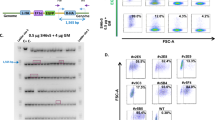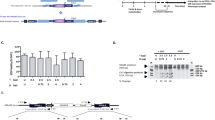Abstract
Synthetic oligodeoxynucleotides (ODNs) had been employed in gene modification and represent an alternative approach to ‘cure’ genetic disorders caused by mutations. To test the ability of ODN-mediated gene repair in bone marrow-derived mesenchymal stem cells (MSCs), we established MSCs cell lines with stably integrated mutant neomycin resistance and enhanced green fluorescent protein reporter genes. The established cultures showed morphologically homogenous population with phenotypic and functional features of mesenchymal progenitors. Transfection with gene-specific ODNs successfully repaired targeted cells resulting in the expression of functional proteins at relatively high frequency approaching 0.2%. Direct DNA sequencing confirmed that phenotype change resulted from the designated nucleotide correction at the target site. The position of the mismatch-forming nucleotide was shown to be important structural feature for ODN repair activity. The genetically corrected MSCs were healthy and maintained an undifferentiated state. Furthermore, the genetically modified MSCs were able to engraft into many tissues of unconditioned transgenic mice making them an attractive therapeutic tool in a wide range of clinical applications.
This is a preview of subscription content, access via your institution
Access options
Subscribe to this journal
Receive 12 print issues and online access
$259.00 per year
only $21.58 per issue
Buy this article
- Purchase on Springer Link
- Instant access to full article PDF
Prices may be subject to local taxes which are calculated during checkout







Similar content being viewed by others
References
Baksh D, Song L, Tuan RS . Adult mesenchymal stem cells: characterization, differentiation, and application in cell and gene therapy. J Cell Mol Med 2004; 8: 301–316.
Kassem M . Mesenchymal stem cells: biological characteristics and potential clinical applications. Cloning Stem Cells 2004; 6: 369–374.
Minguell JJ, Erices A, Conget P . Mesenchymal stem cells. Exp Biol Med (Maywood) 2001; 226: 507–520.
Tuan RS, Boland G, Tuli R . Adult mesenchymal stem cells and cell-based tissue engineering. Arthritis Res Ther 2003; 5: 32–45.
Bieback K, Kern S, Kluter H, Eichler H . Critical parameters for the isolation of mesenchymal stem cells from umbilical cord blood. Stem Cells 2004; 22: 625–634.
Prockop DJ, Gregory CA, Spees JL . One strategy for cell and gene therapy: harnessing the power of adult stem cells to repair tissues. Proc Natl Acad Sci USA 2003; 100 (Suppl 1): 11917–11923.
Meyerrose TE, De Ugarte DA, Hofling AA, Herrbrich PE, Cordonnier TD, Shultz LD et al. In vivo distribution of human adipose-derived mesenchymal stem cells in novel xenotransplantation models. Stem Cells 2007; 25: 220–227.
Lieberman JR, Le LQ, Wu L, Finerman GA, Berk A, Witte ON et al. Regional gene therapy with a BMP-2-producing murine stromal cell line induces heterotopic and orthotopic bone formation in rodents. J Orthop Res 1998; 16: 330–339.
Lou J, Xu F, Merkel K, Manske P . Gene therapy: adenovirus-mediated human bone morphogenetic protein-2 gene transfer induces mesenchymal progenitor cell proliferation and differentiation in vitro and bone formation in vivo. J Orthop Res 1999; 17: 43–50.
Musgrave DS, Bosch P, Ghivizzani S, Robbins PD, Evans CH, Huard J . Adenovirus-mediated direct gene therapy with bone morphogenetic protein-2 produces bone. Bone 1999; 24: 541–547.
Peterson B, Zhang J, Iglesias R, Kabo M, Hedrick M, Benhaim P et al. Healing of critically sized femoral defects, using genetically modified mesenchymal stem cells from human adipose tissue. Tissue Eng 2005; 11: 120–129.
van Tuyn J, Knaan-Shanzer S, van de Watering MJ, de Graaf M, van der Laarse A, Schalij MJ et al. Activation of cardiac and smooth muscle-specific genes in primary human cells after forced expression of human myocardin. Cardiovasc Res 2005; 67: 245–255.
McMahon JM, Conroy S, Lyons M, Greiser U, O'Shea C, Strappe P et al. Gene transfer into rat mesenchymal stem cells: a comparative study of viral and nonviral vectors. Stem Cells Dev 2006; 15: 87–96.
Lee CI, Kohn DB, Ekert JE, Tarantal AF . Morphological analysis and lentiviral transduction of fetal monkey bone marrow-derived mesenchymal stem cells. Mol Ther 2004; 9: 112–123.
Totsugawa T, Kobayashi N, Okitsu T, Noguchi H, Watanabe T, Matsumura T et al. Lentiviral transfer of the LacZ gene into human endothelial cells and human bone marrow mesenchymal stem cells. Cell Transplant 2002; 11: 481–488.
Zhang XY, La Russa VF, Reiser J . Transduction of bone-marrow-derived mesenchymal stem cells by using lentivirus vectors pseudotyped with modified RD114 envelope glycoproteins. J Virol 2004; 78: 1219–1229.
Ju XD, Lou SQ, Wang WG, Peng JQ, Tian H . Effect of hydroxyurea and etoposide on transduction of human bone marrow mesenchymal stem and progenitor cell by adeno-associated virus vectors. Acta Pharmacol Sin 2004; 25: 196–202.
Kumar S, Mahendra G, Nagy TR, Ponnazhagan S . Osteogenic differentiation of recombinant adeno-associated virus 2-transduced murine mesenchymal stem cells and development of an immunocompetent mouse model for ex vivo osteoporosis gene therapy. Hum Gene Ther 2004; 15: 1197–1206.
Lu L, Zhao C, Liu Y, Sun X, Duan C, Ji M et al. Therapeutic benefit of TH-engineered mesenchymal stem cells for Parkinson's disease. Brain Res Brain Res Protoc 2005; 15: 46–51.
Stender S, Murphy M, O'Brien T, Stengaard C, Ulrich-Vinther M, Soballe K et al. Adeno-associated viral vector transduction of human mesenchymal stem cells. Eur Cell Mater 2007; 13: 93–99;discussion 99.
Miller DG, Adam MA, Miller AD . Gene transfer by retrovirus vectors occurs only in cells that are actively replicating at the time of infection. Mol Cell Biol 1990; 10: 4239–4242.
Palmer TD, Rosman GJ, Osborne WR, Miller AD . Genetically modified skin fibroblasts persist long after transplantation but gradually inactivate introduced genes. Proc Natl Acad Sci USA 1991; 88: 1330–1334.
Donahue RE, Kessler SW, Bodine D, McDonagh K, Dunbar C, Goodman S et al. Helper virus induced T cell lymphoma in nonhuman primates after retroviral mediated gene transfer. J Exp Med 1992; 176: 1125–1135.
Kozarsky KF, Wilson JM . Gene therapy: adenovirus vectors. Curr Opin Genet Dev 1993; 3: 499–503.
Byun HM, Suh D, Jeong Y, Wee HS, Kim JM, Kim WK et al. Plasmid vectors harboring cellular promoters can induce prolonged gene expression in hematopoietic and mesenchymal progenitor cells. Biochem Biophys Res Commun 2005; 332: 518–523.
Haleem-Smith H, Derfoul A, Okafor C, Tuli R, Olsen D, Hall DJ et al. Optimization of high-efficiency transfection of adult human mesenchymal stem cells in vitro. Mol Biotechnol 2005; 30: 9–20.
Moutsatsos IK, Turgeman G, Zhou S, Kurkalli BG, Pelled G, Tzur L et al. Exogenously regulated stem cell-mediated gene therapy for bone regeneration. Mol Ther 2001; 3: 449–461.
Park J, Ries J, Gelse K, Kloss F, von der Mark K, Wiltfang J et al. Bone regeneration in critical size defects by cell-mediated BMP-2 gene transfer: a comparison of adenoviral vectors and liposomes. Gene Therapy 2003; 10: 1089–1098.
Song L, Chau L, Sakamoto Y, Nakashima J, Koide M, Tuan RS . Electric field-induced molecular vibration for noninvasive, high-efficiency DNA transfection. Mol Ther 2004; 9: 607–616.
Aslan H, Zilberman Y, Arbeli V, Sheyn D, Matan Y, Liebergall M et al. Nucleofection-based ex vivo nonviral gene delivery to human stem cells as a platform for tissue regeneration. Tissue Eng 2006; 12: 877–889.
Igoucheva O, Alexeev V, Yoon K . Targeted gene correction by small single-stranded oligonucleotides in mammalian cells. Gene Therapy 2001; 8: 391–399.
Igoucheva O, Alexeev V, Pryce M, Yoon K . Transcription affects formation and processing of intermediates in oligonucleotide-mediated gene alteration. Nucleic Acids Res 2003; 31: 2659–2670.
Igoucheva O, Alexeev V, Scharer O, Yoon K . Involvement of ERCC1/XPF and XPG in oligodeoxynucleotide-directed gene modification. Oligonucleotides 2006; 16: 94–104.
Igoucheva O, Alexeev V, Yoon K . Mechanism of gene repair open for discussion. Oligonucleotides 2004; 14: 311–321.
Igoucheva O, Alexeev V, Yoon K . Oligonucleotide-directed mutagenesis and targeted gene correction: a mechanistic point of view. Curr Mol Med 2004; 4: 445–463.
Igoucheva O, Alexeev V, Yoon K . Differential cellular responses to exogenous DNA in mammalian cells and its effect on oligonucleotide-directed gene modification. Gene Therapy 2006; 13: 266–275.
Alexeev V, Igoucheva O, Yoon K . Simultaneous targeted alteration of the tyrosinase and c-kit genes by single-stranded oligonucleotides. Gene Therapy 2002; 9: 1667–1675.
Igoucheva O, Yoon K . Gene targeting by oligonucleotides in keratinocytes. Methods Mol Biol 2005; 289: 287–302.
Pierce EA, Liu Q, Igoucheva O, Omarrudin R, Ma H, Diamond SL et al. Oligonucleotide-directed single-base DNA alterations in mouse embryonic stem cells. Gene Therapy 2003; 10: 24–33.
Murphy BR, Moayedpardazi HS, Gewirtz AM, Diamond SL, Pierce EA . Delivery and mechanistic considerations for the production of knock-in mice by single-stranded oligonucleotide gene targeting. Gene Therapy 2007; 14: 304–315.
Tran ND, Liu X, Yan Z, Abbote D, Jiang Q, Kmiec EB et al. Efficiency of chimeraplast gene targeting by direct nuclear injection using a GFP recovery assay. Mol Ther 2003; 7: 248–253.
Pittenger MF, Mackay AM, Beck SC, Jaiswal RK, Douglas R, Mosca JD et al. Multilineage potential of adult human mesenchymal stem cells. Science 1999; 284: 143–147.
Lecka-Czernik B, Gubrij I, Moerman EJ, Kajkenova O, Lipschitz DA, Manolagas SC et al. Inhibition of Osf2/Cbfa1 expression and terminal osteoblast differentiation by PPARgamma2. J Cell Biochem 1999; 74: 357–371.
Lefebvre V, de Crombrugghe B . Toward understanding SOX9 function in chondrocyte differentiation. Matrix Biol 1998; 16: 529–540.
Kadiyala S, Young RG, Thiede MA, Bruder SP . Culture expanded canine mesenchymal stem cells possess osteochondrogenic potential in vivo and in vitro. Cell Transplant 1997; 6: 125–134.
Woodbury D, Schwarz EJ, Prockop DJ, Black IB . Adult rat and human bone marrow stromal cells differentiate into neurons. J Neurosci Res 2000; 61: 364–370.
Sun S, Guo Z, Xiao X, Liu B, Liu X, Tang PH et al. Isolation of mouse marrow mesenchymal progenitors by a novel and reliable method. Stem Cells 2003; 21: 527–535.
Martin DR, Cox NR, Hathcock TL, Niemeyer GP, Baker HJ . Isolation and characterization of multipotential mesenchymal stem cells from feline bone marrow. Exp Hematol 2002; 30: 879–886.
Olsen PA, Randol M, Krauss S . Implications of cell cycle progression on functional sequence correction by short single-stranded DNA oligonucleotides. Gene Therapy 2005; 12: 546–551.
Radecke F, Radecke S, Schwarz K . Unmodified oligodeoxynucleotides require single-strandedness to induce targeted repair of a chromosomal EGFP gene. J Gene Med 2004; 6: 1257–1271.
Liu HS, Jan MS, Chou CK, Chen PH, Ke NJ . Is green fluorescent protein toxic to the living cells? Biochem Biophys Res Commun 1999; 260: 712–717.
Stojic L, Brun R, Jiricny J . Mismatch repair and DNA damage signalling. DNA Repair (Amst) 2004; 3: 1091–1101.
Piersma AH, Ploemacher RE, Brockbank KG . Transplantation of bone marrow fibroblastoid stromal cells in mice via the intravenous route. Br J Haematol 1983; 54: 285–290.
Pereira RF, Halford KW, O'Hara MD, Leeper DB, Sokolov BP, Pollard MD et al. Cultured adherent cells from marrow can serve as long-lasting precursor cells for bone, cartilage, and lung in irradiated mice. Proc Natl Acad Sci USA 1995; 92: 4857–4861.
Devine SM, Cobbs C, Jennings M, Bartholomew A, Hoffman R . Mesenchymal stem cells distribute to a wide range of tissues following systemic infusion into nonhuman primates. Blood 2003; 101: 2999–3001.
Allers C, Sierralta WD, Neubauer S, Rivera F, Minguell JJ, Conget PA . Dynamic of distribution of human bone marrow-derived mesenchymal stem cells after transplantation into adult unconditioned mice. Transplantation 2004; 78: 503–508.
Anjos-Afonso F, Siapati EK, Bonnet D . In vivo contribution of murine mesenchymal stem cells into multiple cell-types under minimal damage conditions. J Cell Sci 2004; 117: 5655–5664.
Acknowledgements
This work was supported in part by grants from the National Institute of Arthritis, Musculoskeletal and Skin Diseases (RO3 AR051134) to OI and the National Cancer Institute (PO1-CA72765) to EAP and OI.
Author information
Authors and Affiliations
Corresponding author
Rights and permissions
About this article
Cite this article
Flagler, K., Alexeev, V., Pierce, E. et al. Site-specific gene modification by oligodeoxynucleotides in mouse bone marrow-derived mesenchymal stem cells. Gene Ther 15, 1035–1048 (2008). https://doi.org/10.1038/gt.2008.31
Received:
Revised:
Accepted:
Published:
Issue Date:
DOI: https://doi.org/10.1038/gt.2008.31



